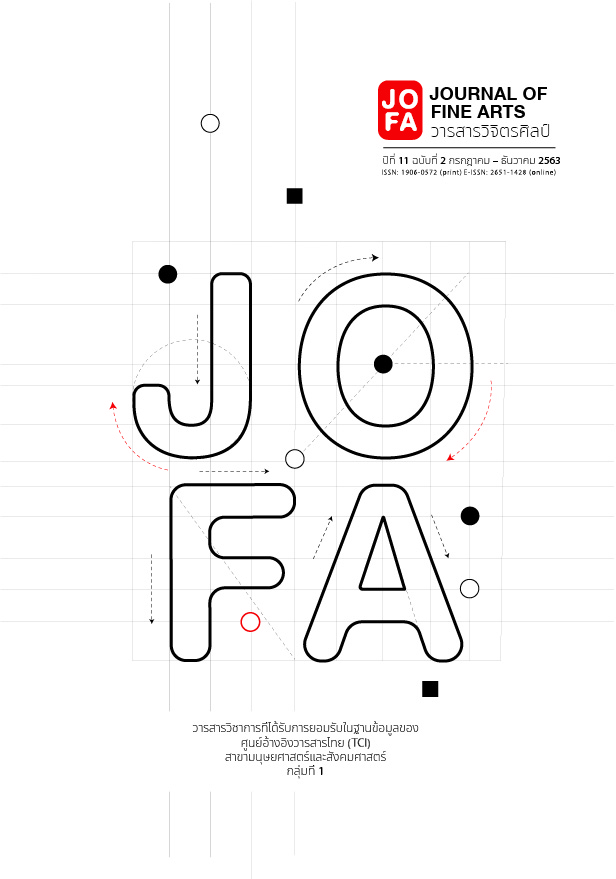New Suggestions for Dating and Concept Interpretation of Murals in Wiharn Nam Taam, Wat Prathat Lampangluang
Main Article Content
Abstract
The murals in Wiharn Nam Taam, Wat Prathat Lampangluang was some influenced by Burmese murals dating from Nyongyan to early Konbaung styles (assumed about early 17th to the second half of 18th century). But it does not concern Burmese concept and believe in that time. These Burmese styles influences were mixed in Lanna culture included the others ethnic groups who immigrated to Lanna .Therefore, the murals in Wiharn Nam Taam appears the specific characteristic which full of aesthetic and high skill The painters might be patronaged by the ruler class of Lampang during the beginning of stable moment about the late of 18th to early of 19th century. In that time, there were also many evidences about the patroness this temple by Chao Chet Ton family and others. So, it was the time suitably to create the murals in Wiharn Nam Taam. Besides the story of the rise of Indra and the story of Samawadi in some murals of Bangkok created in King Rama I period might be influences to murals in Wiharn Namtaam because of the close relation between of Chao Ched Ton family and Chakkri Dynasty in the early Rattanakosin period. The local painters in Lampang adapted these narrative paintings and the styles to be harmonious to the local believes and social situation in that time. All of reasons as the influences from Burmese murals assumed about the early 17th to the second half of the 18th century, the social and political condition of Lampang and the relationship between Lanna and Siam in the second half of 18th century as mentioned can assume that the murals in Wiharn Nam Taam created about the second half of 18th century.
Article Details
References
Damrikul, S. Prawattisat Lae Silpa Lanna. [Lanna History and Art]. Bangkok: Muang Boran, 2018.
Damrong Rajanubhap, HRH Prince. Taew Mueng Pamar. [Journey through Burma]. Bangkok: Klang Wittaya, 1974.
Duangkum, C. Interviewed by Lerdkachatarn,P. Wat Prathat Lampang Luang, Lampang. December 12, 1987.
Falconer, John et al. Burmese Design & Architecture. Singapore: Periplus Editions (HK), 2000.
Green, A.and Blurton,T. Richard. eds. Burma Art and Archaeology. Chicago: Art Media Resources, 2002.
Green, A. “Chak Thongkum Plaew Su Kumpee Puttaprawat: Kaumkeawkong Kub BhuPumipak Tawan-ok Thi Pob Nai Ngan Jittakumfapanang Pamar Yuklang”. [From Gold Leaf to Buddhist Hagiographies:Contact with Regions to the East Seen in Late Burmese Murals]. Journal of Fine Arts 3, no. 2 (July - December, 2012): 22.
Green, A. “Narrative models in late seventeenth to early nineteenth-century Burmese wall painting.” Burma Art and Archaeology. Chicago: Art Media Resources, 2002), 67.
Haripitak, F. Phap Kien Nai Hor Pratripidok Wat Rakangkositaram. [Murals in Tripitaka Hall, Wat Rakangkositaram]. Bangkok: Thai Wattana Panich, 1970.
Jaturawong, C. “Wa Thi Wat Pamar Nai Jangwat Chiang Mai Lae Lampang”. [Myanmar Temple in Chiang Mai and Lampang Provinces]. NAJUA: History of Architecture and Thai Architecture 5, no. 5 (September, 2007): 38 - 65.
Kanokpongchai, S. Wat Dusitaram. Bangkok: Muang Boran, 1983.
Khanthasaibua, S. “Phap Kien Si Pai Nai Wiharn Nam Taam Wat Phra That Lampang Luang”. [Murals Paintings of Wiharn Nam Taam in Wat Phra That Lampang Luang]. Muang Boran 11, no. 3 (July - September, 1985): 109 - 114.
Khin Myo Chit. 5 Area Studies Project. Vol. 10, Colourful Myanmar. Translated by Hom Klayanonta. Bangkok: The Thailand Research Fund (TRF)and 5 Area Studies Project (5 ASP), 2002.
Kruekan, S. Interviewed by Lerdkachatarn, P. Wat Prathat Lampang Luang, Lampang. February 19, 1988.
Krueraya, T. Refered in Patipat Pumpongpattaya. Wat Prathat Lampangluang Restoration Report. Nan: Department of Fine Arts, 2005.
Laohasom, P. Jittrakam Faphanang Laanna. [Lanna Mural Paintings]. Bangkok: Muang Boran, 1998.
Munier-Gaillard, C. “Kaumsampan Rawang Jittrakamfapanang Siam Lae Lanna Rawang Kristasatawat thi 17 – Ton Kristasatawat thi 19”. [17th to Early 19th Century Burmese Murals in Relation to Murals of Siam and Lanna]. Journal of Fine Arts 4, no. 2 (July - December, 2013): 235 - 297.
Munier-Gaillard, C. et al., La Vei du Bouddha: Peintures murals de Haute-Birmanie (Saint-Amand-Montrond (France): Editions Findakly, (2017): 67.
Ranard, A. Burmese Painting A linear and lateral history. Chiang Mai: Silkworm Books, 2009.
Rattanachai, S. et al. Sue Pha Nung Mueng Wattanadham Karn Tangkai Mueng Lampang . [Costume Culture of Mueng Lampang]. Lampang: Lampang Cultural Council and Lampang Cultural Center, 1996.
Saisingha, S. Silpa Lanna. [Lanna Art]. Bangkok: Matichon, 2013.
Sarikawanich, P. “Kunka Chak Ngan Jittakam Nai Wiharn Nam Taam Wat Prathat Lampangluang ”. [The Worth of Murals in Wiharn Nam Taam Wat Prathat Lampangluang]. Silpathat Journal: Faculty of Fine Arts, Rangsit University, 2 (1998): 33 – 46.
Sirarojjananan, M. “Pra-in Nai Kampee Buddhasatsana Theravada”. [Indra in Theravada Buddhist Texts]. Mahachula Academy Journal 5, no.1 (2018): 46 - 47.
Ongsakul, S. History of Lanna 10th ed. Bangkok: Amarin, 2014.
______. Pinit Tamnan Lampang. [Examine in the Legend Lampang]. Lanna Study Center, Faculty of Humanities, Chiang Mai University, 2015.
Thongkhumwan, C. “Lak Thi 78 Silajareuk Thi Wat Prathat Lampangluang Changwat Jor Sor 1158 (Por Sor 2339)”. [Stone Inscription no.78 at Wat Prathat Lampangluang 1796 A.D.]. Stone Inscription Annals no. 3. Bangkok: Office of the Prime Minister’s House, 1965.
Wichienkeaw, A. And David K. Wyatt Tam Nan Pauen Meung Chiang Mai. [Native Legend of Chiang Mai]. Rev.2nd ed. Chiang Mai: Silkworm Books, 2004.
U Tin Lwin. “Old Burmese Painting”. Accessed May 19, 2017. http://www.oriens-extremeus._16pdf.
“Pongsaowadan Mueng Chiang Mai Mueng Lampang Mueng Lampoonchai”. [The Chronicles of Chiang Mai, Lampang and Lampoonchai]. Chronicle Annals. Vol. 3. Bangkok: Kurusapa Business Organization, 1963.


